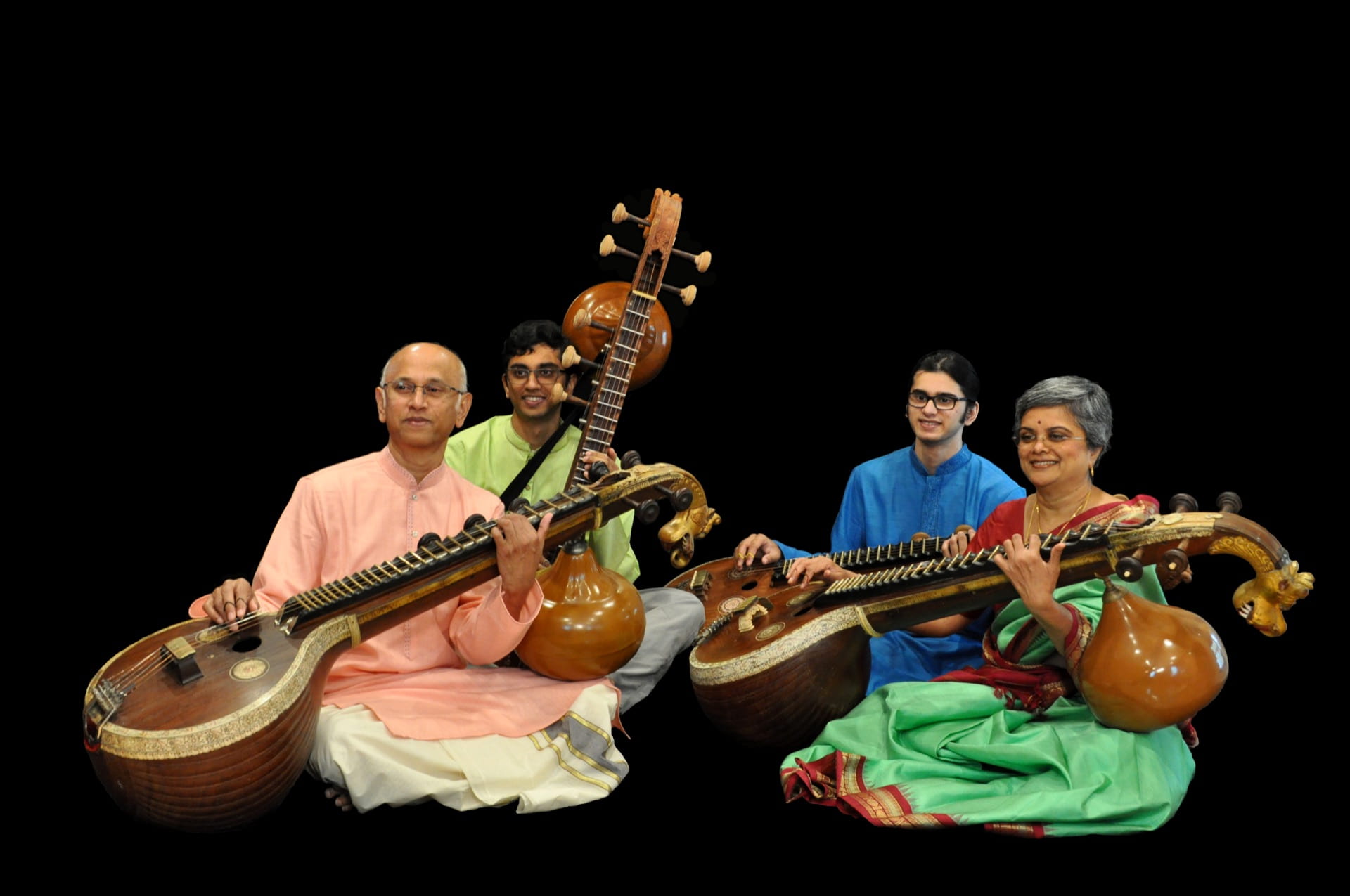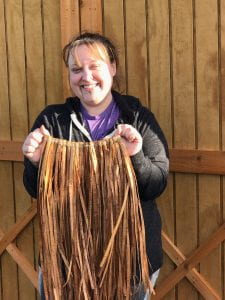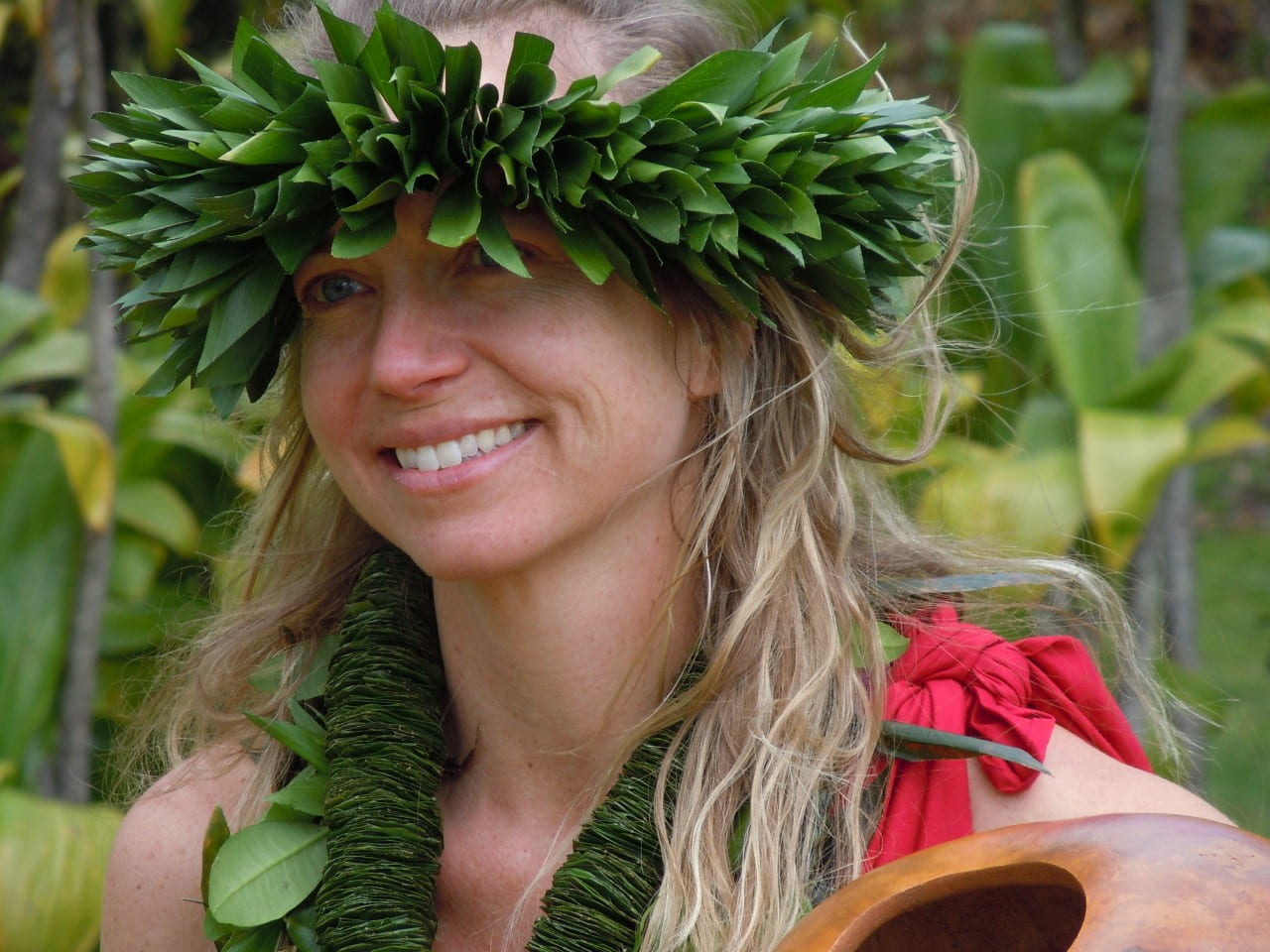We are excited to introduce the 2023 TAAP awardee cohort!
The TAAP program offers folk and traditional master artists and culture keepers a $3,500 stipend to teach their art form to apprentices from their same communities, Tribes, sacred or occupational groups. The stipend supports master artists in sharing their knowledge, skills and expertise with apprentices of great promise who will be empowered to carry on and strengthen Oregon’s living cultural traditions.
Meet the 2023 TAAP Award Recipients:
Sreevidhya Chandramouli

Sreevidhya Chandramouli with the Chandramoulis quartet
Sreevidhya is a tenth generation descendent from the illustrious Karaikudi Vina Tradition of South India. She trained in the traditional gurukulam (living with/near the teacher) setting under her mother Rajeswari Padmanabhan. Sreevidhya has served as artist-in-residence at University of Washington and University of Oregon and briefly served as adjunct faculty at University of Oregon. She has been teaching in the Pacific Northwest for more than three decades preserving the subtle aesthetics and purity of the Karaikudi Vina tradition. She is a founding member of the nonprofit organization Dhvani dedicated to the education, preservation and dissemination of art forms of India.
Apprentice: Nidhi Yadalam
Nidhi Yadalam is an Indian American musician of South-Indian heritage. Through this apprenticeship, she will connect with her cultural traditions through exploring various styles of Carnatic music and other art forms, as well as learning about languages, mythology, and folk narratives. Nidhi has studied under Sreevidhya Chandramouli for five years and they have been working together to further her knowledge on improvisational, lyrical, rhythmic, and emotive elements of Carnatic music. Through the apprenticeship, Nidhi wishes to ultimately be able to assist her teacher in classes, and mentor her juniors. She believes that being part of imparting this art is important to keeping the tradition alive and evolving for generations to come.
Stephanie Craig

Stephanie Craig proudly displays a cache of natural weaving fibers
Stephanie is of Santiam and Yoncalla Kalapuya, Takelma Rogue River, Cow Creek Umpqua, and Clackamas Chinook descent and a seventh-generation traditional basket weaver, tradition keeper, and ethnobotanist (the traditional harvesting, preparation, and storage of indigenous plants). She comes from a long line of strong traditional women-weavers in her tribe. She grew up around basketry and listened to her great-great-aunties and other tribal elders talk about the old ways. Stephanie learned to weave through the oral traditions of her family when she was young. Her weaving and plant teachings have come from traditional weaving elders and other tribal members from neighboring tribes. Besides her early and informal apprenticeships with elders on the Confederated Tribes of the Grand Ronde reservation, The Confederated Tribes of the Chehalis Reservation, Suquamish Indian Tribe, and the Lummi Nation, Craig has studied under three of the most accomplished Tribal basket makers in Oregon – the late Sanda “Sam” Henny of the Grand Ronde Tribe, the late Minerva Soucie of the Burns-Paiute Tribe, the late Pat Courtney Gold (Wasq’u) – and renowned anthropologist Margaret Mathewson. Following the tradition, which encompasses all aspects of basket making, Craig harvests all her own material–beaked and California hazel, sandbar and gray willow, juncus, tule, and cattails–all from traditional sites and other closely guarded gathering spots in the mountains.
Apprentice: Dakota Zimmer
Dakota Zimmer was born in Portland, Oregon. She is an enrolled tribal member of Grand Ronde and descended from Rogue River, Molalla, and Clackamas Tribes. Growing up in Grand Ronde, Dakota has been immersed in tribal culture. In addition to attending pow wows several times a year, Dakota has crafted traditional beaded items throughout the last 20 years. Recently, Dakota has been surrounded by the traditional baskets, materials, and weaving techniques of her ancestors through her employment at her tribe’s museum. This sparked an interest in Dakota to learn more about the traditions of her ancestors. Dakota comes from a line of basket weavers but over time that knowledge of her family was lost. Through her apprenticeship with Stephanie, Dakota can bring this tradition back to her family and community for future generations.
Kumu Hula Andrea Luchese

Kumu Hula Andrea Luchese
Andrea is the Kumu Hula (master teacher) for Hālau Hula Ka Pi’o O Ke Ānuenue “the arch of the rainbow,” a Hawaiian cultural dance school she formed in 2007. She has taught hula in her community since 2003, and in 2014 became an ‘uniki (graduated) kumu hula, under Kumu Hula Raylene Haʻaleleʻa Kawaiaeʻa and Kumu Hula Keala Ching, both native Hawaiians, and the hula traditions of Halau ʻO Haʻaleleʻa and Na Wai ʻIwi Ola, respectively. This formal and rigorous training in the protocols and practices of hula granted her the kuleana (responsibility) to steward and perpetuate these lineally-connected traditions. Andrea was also hanai-ed (adopted) into the lineage of Kumu Hula Sybil Ku’uipo Hewett, who remains a significant mentor of kupuna (elder) wisdom to her today. Kumu Andrea also has a Masters of Arts degree in Dance and Spirituality, and is the founder and president of Kapiʻoānuenue, a non-profit cultural arts organization whose mission is to actively participate in the promotion, perpetuation, and preservation of the wisdom and knowledge of the Hawaiian culture and its traditional practices.
Apprentice: Tia ‘Ohi’a Lehua Kumakua ‘Ahihi McLean
Tia was born and raised on the island of Maui. She was named after her beloved tutu (grandmother) the hardworking and humble matriarch of the Pelekai family. Tia had the honor of learning many cultural and spiritual traditions, both in school (Hawaiian history, language, and ‘ukulele), and at home from her Hawaiian side of the family, who were from Waikapu and Hana, Maui. Tia began dancing hula at the age of five from Kumu Hula Iola Balubar. In her teen years, she studied with Kumu Hula Robyn Kneubuhl, hula kahiko (ancient style) with Kumu Hula Keali’i Reichel and hula ‘auana (modern style) with Kumu Hula Uluwehi Guerrero. As an adult, Tia reignited her passion for learning and perpetuating the hula tradition when she became a haumana (student) of Kumu Andrea in 2010. Through weekly classes with Kumu Andrea, workshops with Native practitioners, Hō’ike presentations, and alaka’i (leadership) responsibilities, Tia’s hula knowledge and connection have vastly expanded. Tia has also deepened her ‘ike (knowledge) of hula practices and protocols through being selected by Kumu Andrea to become a ho’opa’a (chanter) to accompany dancers for the hālau (hula school).
Alseny Yansane

Alseny Yansane
Since age seven, Alseny Yansane has been immersed in the musical and dance tradition of his native country, Guinea, West Africa. Alseny trained and performed in many competitions as a dancer, drummer, and acrobat during the dawn of the Republic’s newly won independence from France. Historically, this was a time when art and cultural appreciation and cultivation were at an all-time high and artist training was rigorous and systematic. Artists had to compete on a national level annually to move up to higher ranks of artistic status. These competitions were held in the heart of Alseny’s neighborhood and attracted groups from all over Guinea who represented the art and culture specific to various regions and ethnic groups.
This has given Alseny a wealth of knowledge about the history and cultural diversity behind Guinean performance arts, a solid artistic foundation, and a strong drive for excellence. Alseny has worked with some of Guinea’s most reputable performance groups, including Kemoko Sano’s Ballet Merveilles and Jean Macuely’s Ballet Sanke. In 1993, Alseny was recruited to join the most prestigious of all national groups, the world-renowned Ballet Africains. Chosen to tour with them several times, Alseny has dazzled audiences throughout the United States, Canada, Bermuda, and Morocco.
Apprentice: Mamadouba ‘Papa’ Yansane
Mamadouba ‘Papa’ Yansane is an emerging traditional Guinean drummer who comes from a line of extraordinary artists and performers. Born in Guinea, he has taken part of folkloric events and cultural ceremonies for as long as he can remember and began music in early childhood. Papa has long been praised for his exceptional musical talent which he has been practicing with his father, Alseny Yansane, for the past eight years in Eugene, Oregon. Papa and Alseny have been performing on stage and co-teaching classes and workshops. Since 2020, Papa has been working with his father on the tradition of building and tuning drumheads. He now wishes to take this experience a step further by learning the art of heading a djembe and building dunduns.
José Antonio Huerta

José Antonio Huerta
Jose Antonio Huerta performs traditional charrería, a skill of horsemanship, cattle work, and a sophisticated rope work that dates back to the 1500s. Huerta showcases his work at local community gatherings. Antonio Huerta grew up in a rural village in Jalisco, Mexico. His family made a living farming. They raised cattle, horses, donkeys, pigs, and chickens and he was tasked with the cattle and the horse work. As a result, he developed a passion for charrería. His father and grandparents were excellent horsemen and talented in the use of the rope and always strived to pass on those talents to him. Antonio has now been performing charrería for over 19 years.
Apprentice: Miguel Ruiz Topete, Jr.
Miguel Ruiz Topete, Jr. is a young charro who grew up in Corvallis, Oregon in a family that does farming work. His father has always trained horses and that allowed him to develop an interest in riding, roping, and doing cattle work. Over the years, he has participated, alongside his father, in cultural events such as parades, private parties, and community events where they would perform horse riding and roping. For the past 8 years, they have collaborated with Antonio Huerta who has spearheaded events in the Eugene/Springfield and surrounding areas highlighting the charrería tradition. These experiences have allowed Miguel to find a great sense of community through those activities. Miguel would like to improve his roping skills through an apprenticeship with Antonio. He deeply identifies with the charrería tradition and everything it represents.
This program is funded in part by grants from the National Endowment for the Arts (NEA) and the Oregon Arts Commission. OFN is administered by the Museum of Natural and Cultural History (MNCH) and is supported in part by the Oregon Historical Society, the Oregon Cultural Trust, and the University of Oregon Librairies.